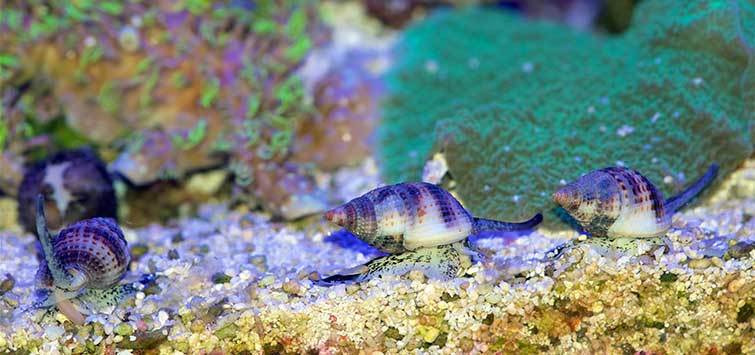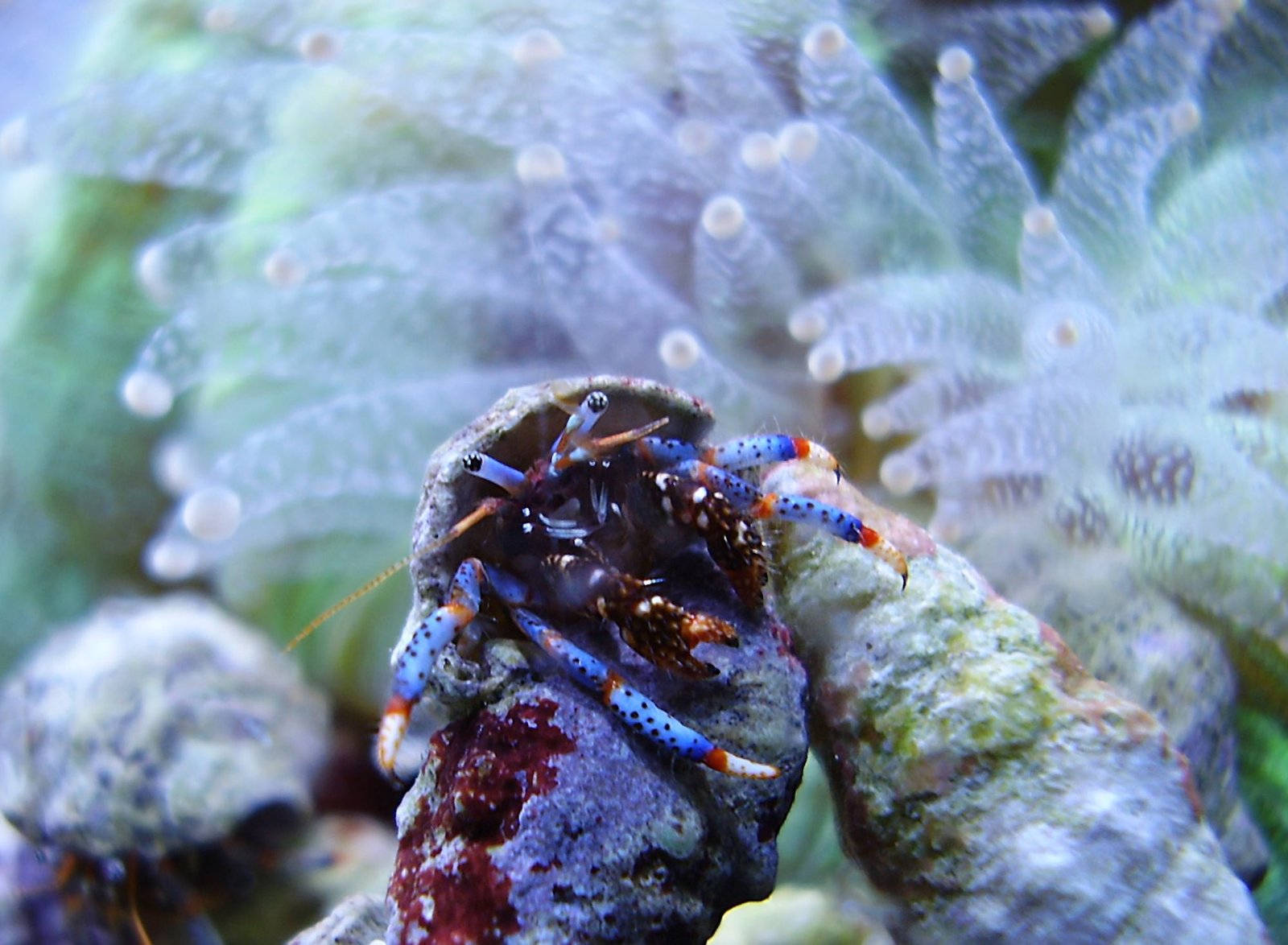Hermit crabs and snails are excellent janitors for reef tanks, as they help clean the tank and remove detritus. They can live together, but it’s best to provide small hermits with plenty of shells that are different from those of the snails.
This ensures they don’t compete for the same shells. The snails are great for cleaning the glass and sifting the sand bed, while the hermits are better at quickly cleaning brown algae. Together, they make a great clean-up crew for your reef tank.

Credit: www.bulkreefsupply.com
Choosing The Right Snails
Hermit crabs and snails are essential janitors for reef tanks, effectively cleaning up debris and algae. They are a popular choice for aquarists due to their beneficial roles in maintaining a healthy aquarium ecosystem.
Different Types Of Snails For Clean-up Crew
When it comes to selecting the ideal snails for your reef tank clean-up crew, it’s important to choose species that will effectively maintain tank cleanliness. Different snail varieties serve different purposes in the aquarium ecosystem. Here are some popular types of snails you can consider:
- Trochus Snails
- Cleaner Snails
- Astraea Snails
- Tiger Conch
- Massarius Snail
- Spiny Star Astraea Snail
Each of these snails has unique characteristics that contribute to the overall cleanliness of your tank.
Benefits Of Snails In Maintaining Tank Cleanliness
Snails play a crucial role in keeping your reef tank clean and thriving. Here are some benefits they provide:
- Algae Control: Snails are excellent algae eaters, helping to control and prevent unwanted algae growth in your tank.
- Detritus Removal: Snails have a knack for scavenging leftover food and decaying matter, ensuring a cleaner and healthier environment.
- Sand Aeration: Some snail species, such as tiger conch and spiny star astraea, actively sift through the sand, preventing it from becoming compacted and helping to maintain proper oxygenation.
- Calcium Regulation: Snails like trochus and astraea play a vital role in calcium regulation by grazing on coralline algae, which promotes healthy coral growth.
With their natural abilities, snails can effectively contribute to the overall balance and cleanliness of your reef tank.
Compatibility Of Snails With Other Tank Inhabitants
Before introducing snails into your tank, it’s crucial to ensure their compatibility with other tank inhabitants. Some important points to consider include:
- Avoid Aggressive Tankmates: Certain fish species may pose a threat to snails, so it’s essential to choose peaceful tankmates that won’t harm or harass them.
- Shell Compatibility: If you already have hermit crabs in your tank, it’s important to make sure the snails you select have different shell preferences. This will prevent any competition or aggression for similar shells.
- Aquarium Size: Different snail species have varying space requirements. Consider the size of your tank to ensure there’s enough room for both the snails and other tank inhabitants.
By carefully considering the compatibility of snails with other tank dwellers, you can create a harmonious and well-balanced ecosystem where all inhabitants can thrive.

Credit: www.tfhmagazine.com
Hermit Crabs As Tank Janitors
Hermit crabs and snails are essential reef tank janitors, as they help clean up the aquarium by eating algae and leftover food. They are a great addition to any tank and can be easily introduced by acclimating them slowly to the water temperature.
H3: Benefits of Hermit Crabs in Reef Tanks If you’re looking for efficient and natural tank janitors for your reef aquarium, hermit crabs are an excellent choice. These small crustaceans serve as a valuable addition to your cleanup crew, providing several benefits to your tank’s overall health and cleanliness. Hermit crabs are known for their scavenging behavior, constantly searching for food remnants and algae that accumulate in the tank. They actively graze on uneaten fish food, dead organisms, and decaying organic matter, preventing them from breaking down and polluting the water. By doing so, they help maintain optimal water quality and reduce the risk of harmful nutrient buildup. Furthermore, hermit crabs play a vital role in preventing algae blooms. They have a natural affinity for consuming certain types of algae, including hair algae and cyanobacteria. Their constant grazing helps control the growth of these unwanted organisms, keeping your tank aesthetically pleasing and maintaining a healthy balance in the ecosystem. In addition to their cleaning abilities, hermit crabs also provide visual interest to your reef tank. Their vibrant colors and unique shell-swapping behavior make them an attractive addition to any aquarium. Watching them scuttle around the tank and interact with their environment adds a dynamic element to your underwater oasis. H3: Choosing the Right Species of Hermit Crabs When it comes to selecting hermit crabs for your reef tank janitors, it’s essential to choose the right species that will thrive in your specific aquarium conditions. Some popular species of hermit crabs suitable for reef aquariums include the Blue Leg Hermit Crab (Clibanarius tricolor), the Scarlet Reef Hermit Crab (Paguristes cadenati), and the Halloween Hermit Crab (Ciliopagurus strigatus). Each species has its own unique traits and preferences, so consider factors such as tank size, water parameters, and compatibility with other tank inhabitants when making your selection. It’s also important to provide a sufficient number of empty shells for your hermit crabs. These creatures rely on empty shells as their protective homes, and having an adequate supply will prevent them from evicting and possibly harming other tank inhabitants, such as snails. Make sure the shells are appropriate in size and shape for your chosen hermit crab species to ensure their comfort and well-being. H3: Caring for Hermit Crabs in Aquariums Proper care and attention are crucial for maintaining healthy hermit crabs in your reef aquarium. Here are a few tips for ensuring their well-being: 1. Water Quality: Hermit crabs thrive in stable and clean water conditions. Regular water testing, filtration maintenance, and regular water changes will help provide a healthy environment for them. 2. Diet: Supplement your hermit crabs’ natural scavenging behavior with a varied diet. Offer them a mix of algae wafers, dried seaweed, and small portions of meaty foods like fish or shrimp. Provide them with ample feeding areas to reduce competition amongst tank inhabitants. 3. Shell Maintenance: Regularly inspect the shells of your hermit crabs to ensure they have suitable homes. If necessary, provide additional empty shells for them to switch into. Avoid using painted or artificial shells, as they can be harmful to the hermit crabs. 4. Compatibility: Keep an eye on your hermit crabs’ interactions with other tank inhabitants. While generally peaceful, they may occasionally become aggressive towards other hermit crabs or snails. If aggression is observed, provide additional hiding spots or consider separating them if necessary. Remember, hermit crabs are living creatures that require attention and care. By ensuring their well-being, you can enjoy their benefits as efficient and entertaining tank janitors in your reef aquarium.
Credit: aquariumbreeder.com
Frequently Asked Questions Of Reef Tank Janitors: Hermit Crabs And Snails
Can Hermit Crabs Live With Snails?
Yes, hermit crabs can live with snails. It is best to get small hermits and provide plenty of shells to avoid conflict. Small blue legged hermits and a mix of Black footed trochus, astrea, and nassarius snails are a good combination.
What Is The Best Snail For A Clean Up Crew?
The best snail for a clean up crew is a combination of small blue legged hermit crabs and a mix of Black footed trochus, astrea, and nassarius snails.
What Is The Symbiotic Relationship Between A Hermit Crab And A Snail Shell?
Hermit crabs live in shells made and abandoned by snails, without harming or benefiting the snails. This is a symbiotic relationship known as commensalism.
How Do You Acclimate Snails And Hermit Crabs?
To acclimate snails and hermit crabs, place the sealed bag on the aquarium water and let it float without opening it. This allows the snail’s water to adjust to the tank’s temperature. After about fifteen minutes, remove the bag.
Conclusion
Hermit crabs and snails are essential janitors in a reef tank, providing effective cleaning and maintenance. While snails excel at glass cleaning and sand sifting, hermit crabs are experts in quickly eliminating brown algae. By introducing a combination of these creatures, you can ensure a clean and healthy environment for your aquarium.
Their symbiotic relationship, where hermit crabs utilize abandoned snail shells, showcases nature’s fascinating dynamics. So, create a thriving reef ecosystem by incorporating these tank cleaning superheroes.

